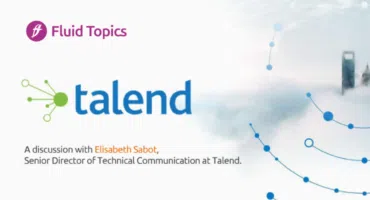
A discussion with Sophie McMonagle, Senior Technical Writer and Portal Product Owner at Napatech.
Sophie, we understand you are a technical author working as part of marketing?
Yes, I work in the global marketing team. Which is interesting because I am indeed a technical author. I’ve worked in companies before where technical authoring was in a different area in the organization, like support, engineering, development. At Napatech, being in global marketing allows me to have a holistic view of our world, to establish synergies between the different parts of the company.
Historically, how was Napatech delivering tech doc?
When I joined Napatech, I realized very quickly how complex our technical documentation is. We are talking about serious low-level hardware and software here. There are many different varieties of accelerators and multiple configurations. In terms of documentation, that means a huge number of combinations, and also a lot of reuse, which was one of the major advantages of using DITA. We delivered documentation as PDFs and as WebHelp, under a Non-Disclosure Agreement (NDA). This meant that none of our technical content was public. The PDFs were fine, however the user experience of the WebHelp was really terrible in terms of search.
About Napatech

Headquartered in Copenhagen, Denmark with offices in US, Napatech has been building network acceleration solutions for the past 15 years. The company’s SmartNICs are used in the world’s largest datacenters by demanding customers such as network providers, telecom companies, high-frequency traders – every time laser-sharp speed in network acceleration is required.
What prompted the move to dynamic delivery?
The way we were delivering documentation was hurting us in terms of visibility. A lot of our customers are OEM, they buy our components and resell them on, so we were almost invisible as a web presence. In order to give us visibility, we needed relevant content, content that would provide value to users and increase our ranking by web search engines. That was one of my big projects when I came in. I saw how important it would be to get an internet presence.
The first hurdle we had to remove was the NDA. If we were to make some content publicly accessible, we needed to decide what could be open and what had to remain confidential, instead of marking everything with a big “NDA” stamp. Some content we wanted to be able to keep confidential or with restricted access, and this was one of our use cases. But we also needed to make it smooth for people who had reasons (and permissions) to find and view that information.
The “ah-ha” moment was when we all realized how big this was and how this would help our business.
How did you set out to find a solution?
The company saw the benefit of lifting the NDA for the great majority of our documentation, which allowed us to then look for the best delivery journey for our customers. With the sponsorship of the Director of Global Marketing, I set out to put together a content delivery prototype and we presented that to the CEO. The feedback was immediate, and quite frankly super positive. I think this was a “ah-ha” moment for everyone, when we all realized how big this was and how this would help our business.
The only concern was that the prototype’s existing search experience was sub-par. So instead of putting together low-cost components and in-house scripts, I was mandated to identify a proven, industrial-grade solution, even if that meant spending some money on it. What the CEO wanted was a lightning fast search, and he wanted it to look really good. It was very clear in terms of message!
So I came up with a lot of use cases, and with the team we agreed on a dozen of the most important ones. We shortlisted a handful of providers, and a few of them deployed systems for us to test with our content. I remember that the Fluid Topics team got their test system up and running within a week. It was immediately easy to use and to upload, and it was already looking beautiful out of the box. It took us very little effort to customize it to our look & feel and requirements. And the search was just amazingly fast and relevant! Anyhow, as a team we all tried every solution, I got everyone to rank the options, there was a really diplomatic discussion and decision but in the end we all agreed Fluid Topics was the best.
The other thing about Fluid Topics is that it is cloudbased, which means zero installation and minimal maintenance! I’m quite happy to get my hands dirty in terms of coding where necessary, but not just for the sake of it. My solution has always been “go simple and be effective”. So even though Fluid Topics comes at a cost, it is still less expensive than deploying and maintaining servers, assembling an ad-hoc software stack, and the hidden costs of having the right people employed to make it all work together. Here comes the first part of our ROI!
The system was up and running within a week. The search was just amazingly fast and relevant.
What type of content do you publish, and for whom?
We have a wide variety of content consumers. First, there are the internal users: our support staff (who love it), system engineers use it a lot too. In terms of customers, the primary users are developers: anyone using the API reference is our biggest hit. We also have technical-level administrators and hardware technicians.In terms of content, currently we have all our technical content available (installation information, data sheets, API, administration content) but we are also ready to start publishing a lot of marketing collateral and website content alongside our technical documentation. It seems to be somewhat unusual to do this, but our view is that you never actually know who is going to be interested in a certain topic. One thing our products do, is integrate with a lot of open source applications, like Snort and Suricata, for example. So if someone is searching on “snort”, how can we say if they are looking for an application data sheet, or a blog entry, or an industry event that is happening? Working in the global marketing organization is giving me that view, which I feel is sometimes missing in Quick Facts content strategies. Sometimes you should not try to predict, but you need to have a strong search, which provides relevant answers and the ability to filter easily. This is the case with Fluid Topics: the search is so powerful, and the filtering is so powerful that you can very quickly get what you need.
Quick facts
Documentation format: DITA
Team: 4 technical authors
Content: around 70 books, 6,700 DITA topics, 6 releases of content, around 200 web pages from the corporate site
Are you able to measure the actual benefits of dynamic delivery?
Actually, we are! Last month we had a 28% increase in hits on the tech website. We actually also had a slight reduction of traffic on the main website.
This is the second part of our ROI: when people look for something specific, they end up in the right location right away.
The increase in visibility is just incredible.
When people look for something specific, they end up in the right location right away.
Are there specific capabilities of Fluid Topics you’d like to mention?
We are heavy users of a lot of Fluid Topics features – the filters are great, and leverage so much of the core tagging that we use in DITA, so there is very little you need to add specifically for Fluid Topics. It is brilliant that you can add all sorts of content to the site – PDFs, videos, images, all alongside the DITA or HTML content. From an administrative perspective, we use the API quite a bit for uploads (content, map attachments, reindexing) and that is really useful as we start to automate our processes for publishing. Another thing I like (there are so many…) is the analytics and the reporting. Fluid Topics captures the search keywords of users, most clicked documents/maps/ topics, etc. This is absolutely fantastic. For example, I heavily use synonyms: as soon as I see what people are searching on, I immediately try to find out and see, is it what they want to find, are there other words used? Then I can go and enrich the taxonomy to make sure they find what they are looking for. And the stuff nobody ever reads, either it’s because it’s useless, or it’s just too hard to find! Fluid Topics helps us make our content better, and more valuable.



